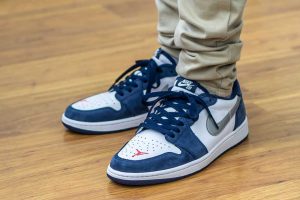People often ask me (and Google) about comparative sizing, wondering if they can buy the same size in different models. In this instance, we’re going to examine Nike Dunk vs Air Jordan 1 sizing.
Do Nike Dunks Fit The Same As Air Jordan 1?
The Air Jordan 1 and Nike Dunk have similar fits. Either will fit true to size, but Nike Dunks have more of a regular fit while Air Jordan 1s have a slightly narrow fit.

This sneaker is more forgiving on width
than older AJ1s, but not by much
Buy AJ1s: eBay
If you are used to wearing other types of Nikes, Air Jordan 1 sizing may throw you off a bit. You can always default to your true size when initially trying a pair out. However if you are like others, you may find the AF1 to have a slightly narrow fit.
Nike Dunks tend to have a standard fit, pretty much true to size. For some foot shapes this may feel slightly big, and for others a bit on the narrow side. Regardless, the differences aren’t so extreme that true to size won’t work in most cases.
This is in contrast to the Air Jordan 1, which compared to a Dunk has a slightly narrow fit. This might even feel snug for some at true to size. Regardless, my preference is to go true to size on Air Jordan 1s AND Nike Dunks.
You can look up Nike’s official size chart here.
Should I Size Up Or Down In Nike Dunks?
Nike Dunks fit true to size. Older Dunks can be a bit more roomy, depending on the materials used and what year they released.

Older dunks like these definitely fit on the
roomier side of true to size.
Buy Dunks: eBay
The Nike Dunk has a somewhat roomy fit, but not enough to change size in most cases. The toebox design is on the wider side. There are some dunks that release that have stiffer materials than others which plays a part in how long the sneaker will take to break in.
With older dunks, the materials tend to be a bit more pliable. Dunks from the late 90s through the mid-late 2000s have an even more accommodating fit than modern pairs. This means that when confronted with a lack of a true-to-size option, older dunks can work at a half size down and still be wearable.
Keep in mind we are discussing regular dunks here and not SB Dunks. SB Dunks follow a similar trajectory; earlier pairs fit a bit more loosely with better materials. However, modern pairs can be very snug. I often have to size up on modern SB Dunks, but never on regular dunks.
I do find the cheaper materials on some of the newer general release Dunks to inspire a roomy feel, but in a different way to older dunks. Instead of soft, pliable materials providing a looser feeling fit, its the very thin leather composition that gives the extra room. The end result is that newer dunks tend to feel and look less quality on feet, and hug the foot less. Additionally, the creasing looks a bit different as the low quality leather breaks in.
With all that said, when it comes to Nike Dunk vs Air Jordan 1, I definitely give the edge to Dunks on roominess.
Are Dunks More Comfortable Than Jordans?
The slightly looser fit on the Nike Dunk makes them more immediately comfortable than many Air Jordan retros, generally speaking. Some may find specific Air Jordan models to be more comfortable though, depending on foot shape.

Generally a pair like this is lighter and less boot-like than most Air Jordan retros.
Again, this applies only to regular dunks. I’ve often found SB Dunk lows to have more padding than regular dunks, which results in them feeling more snug in some cases. For regular dunks though, the fit surrounding the feet is about the same, generally looser than many early Air Jordan models.
The materials used on most general Dunk releases tend to not be as stiff as those used on a bulky Jordan retro. Thus, the step-in comfort is typically more present in the Dunk.
That said, some will find certain Air Jordan models to be very comfortable. For example, I like the Jordan 3, 7 and 13 for immediate comfort. Compared to these models, the advantage Dunks have would be the simpler layout and lighter weight overall. Even the most comfortable Jordan retros still have a bulk to them not found in most Dunk releases.
Layout Differences Between Dunks and Jordan 1s
Nike Dunks have slightly different paneling than the Air Jordan 1, particularly around the wings, swoosh and eyelets. They also have a less shapely silhouette and generally do not have Nike Air in the midsole.

These might feel “bigger” due to less
constriction around the ankle, but
length/width is the same as the AJ1 High.
Both cuts fit more narrow than their
Dunk counterparts.
It’s in the name: the Air Jordan 1 has Nike Air in it. Despite having this tech, the shoe is often cited as less comfortable than the Nike Dunk. The Air unit itself offers little cushioning, and instead is a way of getting the weight down in the midsole. Underfoot, the kicks feel about the same.
There are some differences in the paneling and silhouette between the two models. Dunks of course have a slightly roomier fit, which you can see and feel in the toebox area. The Air Jordan 1 has a more “shapely” look to it’s silhouette; even the midsole width appears to narrow a bit more in the midfoot.
The Air Jordan 1 has a panel on the side of the toebox that extends up into the bottom 3 eyelets. On the Air Jordan 1 High, the top wing flap is stitched in and contains the top two eyelets. Meanwhile, the Dunk High’s top eyelet is above the wing flap, which hangs loose when not laced. This layout sometimes varies with release year.
Another difference is the swoosh placement, as Dunks tend to have the swoosh running directly through the wing panel. The Jordan 1 High swoosh appears to split the edges of the heel and wing panels, effectively bisecting them on many colorways.
One thing is for sure, AJ1s and Dunks feel and look similar on feet at the same size. Both are also classics, and are streetwear standards for a reason. They are both going to look great in your wardrobe. Just keep in mind that Air Jordan 1 sizing and appearance is generally narrower and more shapely when compared to the Nike Dunk.
Need to translate your size from Mens -> Women’s, UK or JP sizes? Try my new shoe size calculator.
